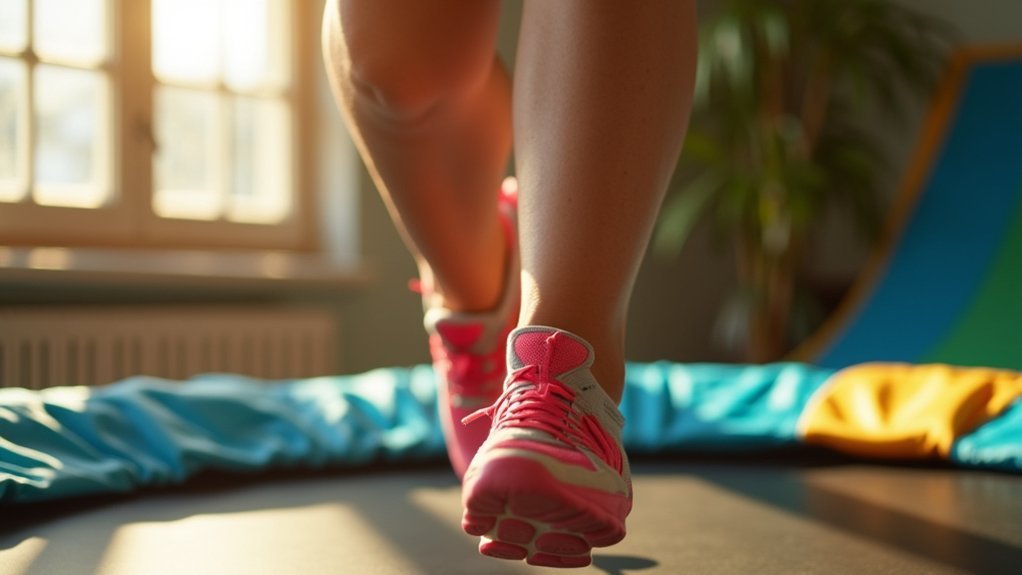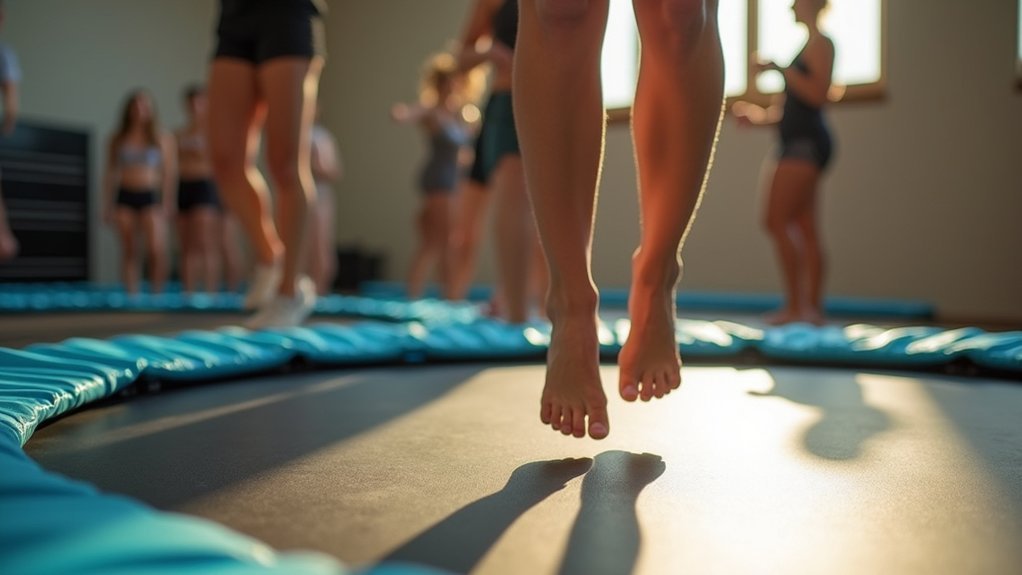Fitness experts reject seven common cellulite claims: spot reduction through rebounding, quick 2-3 week results, rebounding alone fixing connective tissue issues, detoxification benefits, significant skin elasticity improvements, lymphatic drainage as a miracle solution, and rebounding superiority over traditional exercise. While rebounding offers legitimate health benefits like improved circulation and core engagement, it can’t structurally transform cellulite-affected areas without complementary approaches. Understanding these misconceptions helps you develop realistic expectations and more effective strategies for addressing cellulite concerns.
“Spot Reduction” Claims: Why Rebounding Can’t Target Cellulite

Although countless fitness influencers promote mini-trampolines as cellulite-fighting tools, the scientific evidence tells a different story.
The fundamental premise of spot reduction—exercising to remove fat from specific areas—doesn’t apply to cellulite, which isn’t just fat but a complex structural issue involving fibrous septae.
When you rebound, your body doesn’t selectively metabolize fat from cellulite-affected areas. The dimpled appearance stems from connective tissue tension that exercise alone can’t address.
Even if rebounding helps with overall fat loss, it won’t alter the underlying architecture causing cellulite’s characteristic appearance. Effective treatments like Cellfina™ and Cellulaze™ specifically target these structural components, which is why they show measurable results.
No peer-reviewed research supports rebounding as an effective cellulite treatment. The mechanical action simply lacks the intensity needed to modify fibrous structures or induce the collagen remodeling necessary for meaningful improvement.
The Myth of Quick Cellulite Elimination Through Rebounding
Despite viral social media trends promising you’ll erase cellulite within weeks through rebounding, scientific evidence paints a more sobering picture. The timeline claims of “cellulite-free in 2-3 weeks” lack clinical validation and overlook the structural nature of cellulite that mini-trampoline workouts simply can’t address.
- No clinical studies establish a timeline for rebounding-specific cellulite reduction, making those “14-day transformation” claims scientifically unfounded.
- Temporary improvements you notice likely reflect reduced fluid retention rather than structural changes to fat deposits or connective tissue.
- Before-and-after photos touted in testimonials often feature lighting, posture, and angle manipulations that exaggerate results.
While rebounding does improve lymphatic flow by stimulating the opening and closing of lymphatic valves, this alone isn’t sufficient to eliminate established cellulite patterns.
You’ll need a multifaceted, long-term approach—not just rebounding—to see meaningful cellulite improvement.
Why Rebounding Alone Doesn’t Fix Connective Tissue Issues

Your rebounding routine won’t solve connective tissue problems because these issues extend beyond what simple bouncing can reach.
You’ll need thorough approaches that address body-wide tissue health, including specialized exercises targeting fascia and other connective structures.
Combining rebounding with resistance training, stretching, and mobility work creates the integrated movement approach necessary for meaningful tissue improvement.
The optimal approach incorporates functional core training through rebounding which targets deeper muscles effectively while promoting proper movement patterns for connective tissue health.
Deeper Than Surface Bounce
While rebounding on mini-trampolines can stimulate lymphatic drainage and improve circulation, it doesn’t address the complex structural issues underlying cellulite. Your body’s connective tissue limitations require more targeted approaches.
The bouncing motion fails to modify the rigid collagen cross-linking patterns in your fascia or break down the fibrous septae causing dimpling. Despite creating twice the gravity during landing compared to running, rebounding can’t penetrate deep enough to remodel the extracellular matrix where cellulite forms. Even with consistent practice, rebounding can’t penetrate deep enough to remodel the extracellular matrix where cellulite forms.
- Your body’s collagen structure doesn’t change from vertical bouncing movements alone
- Genetic and hormonal factors affecting fat distribution remain unaltered by gravitational forces
- Bouncing lacks the multidirectional shearing forces needed to break up adhesions
For meaningful cellulite reduction, complement rebounding with manual therapy, collagen-supporting nutrition, and specialized treatments designed to address fascial restrictions directly.
Body-Wide Tissue Improvements
Although rebounding exercises stimulate circulation throughout the body, they fundamentally miss the structural complexity needed for genuine cellulite improvement.
Cellulite develops from an imbalance between the dermis, adipose tissue, and septa at the subdermal junction. Your skin’s structure requires specific interventions that target these deeper mechanisms.
Effective treatments like radiofrequency and endermologie work by enhancing collagen production, strengthening septae, and improving the skin envelope structure—not just by temporarily increasing blood flow.
These approaches address the biomechanical imbalances causing fat herniation through weakened connective tissues.
While rebounding might temporarily improve circulation, it can’t reverse the hormonal, genetic, and structural factors that determine your tissue health.
Real cellulite improvement requires thorough approaches that target the specific architecture of your connective tissues, not just superficial bounce.
Integrated Movement Approach
Despite its popularity as a low-impact workout, rebounding fails to address the complex matrix of connective tissue issues that define cellulite.
While bouncing on a mini-trampoline can improve circulation and lymphatic drainage, it doesn’t target the fibrosis and adhesions that contribute to dimpled skin.
You’ll see better results by integrating multiple approaches:
- Combine rebounding with strength training to build muscle underneath affected areas, creating a firmer foundation
- Add manual therapies like deep tissue massage or dry brushing to break down fibrotic tissue and improve blood flow
- Incorporate specific yoga or stretching movements that target connective tissue flexibility
Rebounding and Toxin Release: Separating Fact From Fiction

While rebounding advocates claim it flushes toxins through lymphatic stimulation, scientific evidence supporting this specific detoxification effect remains limited beyond what general exercise provides.
The cellular vibration you experience during rebounding does improve circulation and stimulate lymphatic flow, but these benefits don’t directly translate to significant cellulite reduction.
Your body’s natural detoxification happens primarily through your liver and kidneys—not through bouncing on a mini-trampoline, despite the improved blood flow that rebounding creates. Regular rebounding can provide enhanced lymphatic drainage which promotes general wellness, though this doesn’t equate to toxin elimination as often marketed.
Toxin Release Evidence Examined
Claims that rebounding exercises flush toxins from the body have gained traction in wellness circles, yet these assertions lack substantial scientific backing. When you examine the evidence, you’ll find no studies demonstrating measurable toxin reduction from bouncing on mini-trampolines. The lymphatic system primarily transports waste cells and proteins—not environmental toxins as commonly suggested.
- McGill University and Healthline have explicitly refuted these “detoxification” claims as unsubstantiated.
- White blood cell increases after rebounding are comparable to those from other forms of exercise.
- The “flush your entire system in 2 minutes” claim originates from non-replicated alternative medicine sources.
While rebounding offers legitimate benefits like low-impact cardio and potential bone density improvements, its supposed detoxifying effects remain scientifically unsupported. Rebounding does engage core muscles effectively during exercise, providing real fitness benefits that shouldn’t be confused with unproven detoxification claims. The reality is that general exercise benefits are often misattributed specifically to rebounding’s “detox” properties.
Cellular Vibration Benefits
Looking beyond the detoxification claims, the concept of cellular vibration deserves careful scientific examination.
Whole-body vibration (WBV) therapy, which involves standing on platforms that vibrate between 15-70 Hz, does show evidence-backed benefits.
Studies indicate WBV can improve neuromuscular coordination, enhance bone density, and boost circulation.
You’ll find potential cognitive improvements as research shows altered brain activity following vibration therapy.
The anti-inflammatory effects are particularly promising, with data showing decreased inflammatory cytokines.
When you combine rebounding exercises with vibration techniques, you may experience enhanced results.
These methods offer accessible alternatives if you struggle with mobility issues or traditional exercise.
Though WBV platforms can be expensive, they provide specific benefits targeting bone strength and vascular health that complement conventional fitness approaches.
Circulation vs. Cellulite
Despite popular marketing claims suggesting that rebounding exercises eliminate cellulite by “detoxifying” the body, scientific evidence tells a more nuanced story.
While circulation problems do contribute to cellulite formation—with blood flow 35% lower in affected areas—the connection between rebounding and significant cellulite reduction remains tenuous.
- Research shows lymphatic drainage issues are more relevant than the speculative “toxin buildup” often cited in marketing materials.
- Rebounding may improve circulation and provide indirect benefits, but isn’t a guaranteed cellulite cure.
- The mechanical effects of bouncing could stimulate lymphatic flow, but there’s limited scientific evidence linking this to visible cellulite reduction.
You’ll get cardiovascular benefits from rebounding exercises, but don’t expect dramatic changes in cellulite appearance from this activity alone.
The Truth About Rebounding’s Impact on Skin Elasticity
While rebounding enthusiasts often tout its ability to restore skin elasticity, the scientific evidence doesn’t fully support these claims.
Rebounding may indirectly benefit your skin through improved circulation, which delivers nutrients and oxygen to skin cells while removing toxins.
The low-impact exercise can strengthen underlying muscles, providing better support for your skin. This muscle toning may improve skin appearance, but it won’t restore elastin fibers—the key proteins responsible for skin’s bounce-back quality.
As you age, elastin production naturally decreases, and environmental stressors accelerate this decline.
Unfortunately, few treatments effectively restore elastin, and despite marketing claims, elastin supplements don’t directly enhance skin elasticity.
Rebounding offers legitimate fitness benefits, but managing expectations about its skin-rejuvenating powers is important.
Debunking the Lymphatic Drainage Miracle Claims
Lymphatic drainage treatments marketed as cellulite solutions have gained significant traction, yet fitness experts consistently reject these miracle claims.
Despite enthusiastic marketing, these treatments don’t address cellulite’s structural causes—fibrous septa thickening and fat protrusion—and lack FDA approval or substantial clinical evidence. While lymphatic drainage massage effectively uses light pressure techniques to reduce inflammation and swelling in legitimate medical applications, this doesn’t translate to cellulite reduction.
- No studies demonstrate lymphatic drainage directly breaks down fat or remodels collagen, the actual mechanisms behind cellulite formation.
- Complete protocols require 20+ sessions for minimal results, making them time-intensive and costly compared to proven alternatives.
- The “toxin flushing” narrative lacks scientific specificity about which toxins are targeted or how they relate to visible skin dimpling.
More effective approaches include strength training, topical retinoids, and targeted treatments like radiofrequency or laser therapy that address cellulite’s root causes.
Rebounding vs. Traditional Exercise: Realistic Expectations for Cellulite
Advocates of rebounding exercise on mini-trampolines claim it offers superior cellulite reduction compared to traditional workouts—but these claims deserve careful scrutiny.
While rebounding does firm muscles and boost circulation in cellulite-prone areas like hips and thighs, traditional exercises can be equally effective. Both approaches increase blood flow and stimulate lymphatic drainage—essential factors for improving skin appearance.
Neither guarantees complete cellulite elimination, though both can reduce its visibility. Your results will vary based on genetics, consistency, and overall lifestyle.
Rebounding offers advantages as a low-impact option suitable for all fitness levels, while traditional exercises might burn more calories and target specific muscle groups more intensively. Just 10 minutes of daily rebounding can significantly improve blood circulation throughout the body.
For best results, consider your personal needs and combine your chosen exercise with healthy eating habits rather than expecting miraculous transformations from either approach alone.
Frequently Asked Questions
Can Hormonal Changes Affect Cellulite Development?
Yes, your hormones directly impact cellulite development. Estrogen promotes fat storage, while fluctuations reduce collagen. Puberty, pregnancy, and menopause are key milestones when hormonal shifts can worsen cellulite’s appearance.
Does Genetics Play a Role in Cellulite Formation?
Yes, genetics greatly impacts your cellulite formation. You’ll see this in your skin thickness, fat distribution, and hormonal patterns. If your relatives have cellulite, you’re more likely to develop it too.
Can Dry Brushing Help Reduce Cellulite Appearance?
Dry brushing may temporarily improve cellulite appearance by increasing circulation and exfoliating your skin, but there’s no scientific evidence it provides lasting results. You’ll likely notice smoother skin texture rather than significant cellulite reduction.
How Does Aging Impact Cellulite Visibility?
As you age, your collagen and elastin decrease, making your skin thinner and less elastic. This weakens structural support, allowing fat cells to push through, while hormonal changes and reduced circulation further enhance cellulite visibility.
Are Men and Women Equally Susceptible to Cellulite?
No, you’re not equally susceptible to cellulite based on gender. Women are considerably more affected (85-90%) than men (~10%) due to differences in hormones, skin structure, fat distribution, and collagen strength.
In Summary
You’ve seen the facts: rebounding won’t magically eliminate your cellulite overnight. While it’s a fun, low-impact exercise, don’t expect it to specifically target cellulite, flush toxins, or rebuild connective tissue on its own. For real results, you’ll need a thorough approach combining strength training, proper nutrition, and consistency. Set realistic expectations and remember – if something sounds too good to be true, it probably is.





Leave a Reply